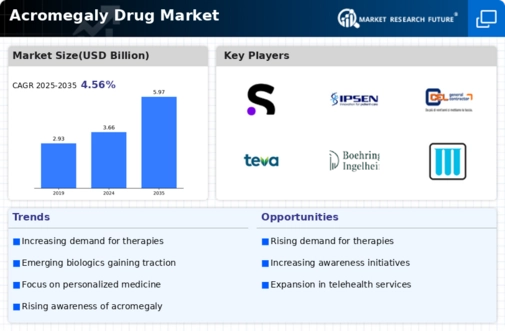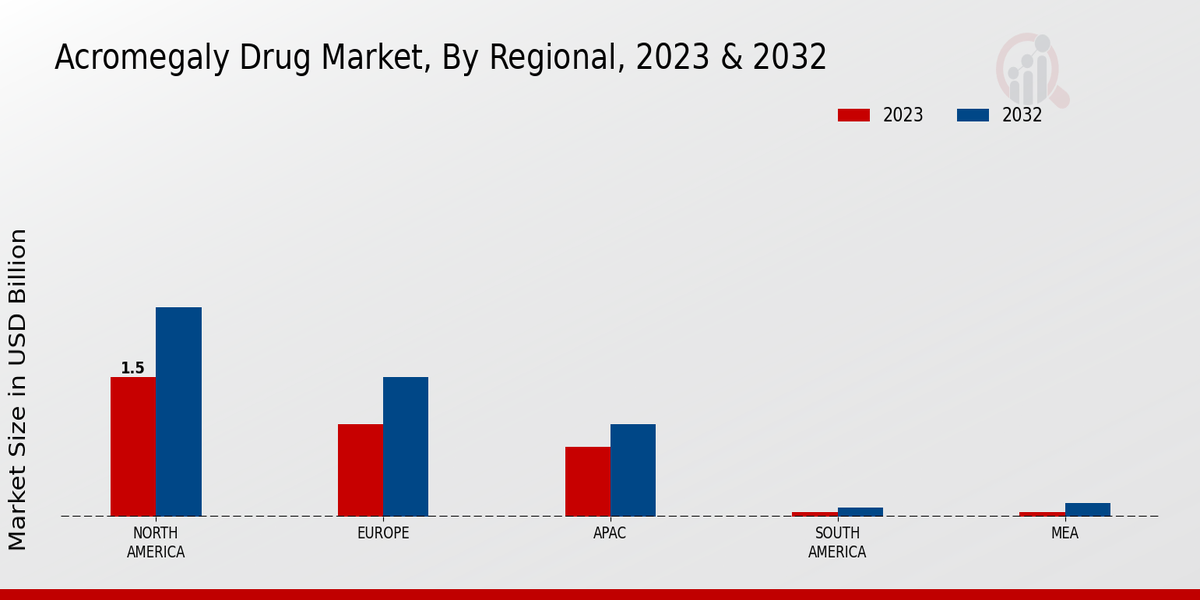Growing Geriatric Population
The aging population worldwide is contributing to the expansion of the Global Acromegaly Drug Market Industry. As individuals age, the risk of developing various health conditions, including hormonal disorders like acromegaly, tends to increase. The World Health Organization projects that the global population aged 60 years and older will reach 2.1 billion by 2050. This demographic shift is likely to result in a higher incidence of acromegaly, thereby driving demand for effective treatment options. Consequently, the market is expected to see sustained growth as healthcare systems adapt to meet the needs of an aging population.
Market Trends and Projections
The Global Acromegaly Drug Market Industry is poised for growth, with projections indicating a market size of 3.66 USD Billion in 2024, expanding to 5.97 USD Billion by 2035. This growth trajectory reflects a CAGR of 4.55% from 2025 to 2035. Factors such as increasing prevalence, advancements in treatment options, and heightened awareness are contributing to this positive outlook. The market's expansion is indicative of a broader trend towards improved management of acromegaly, with ongoing research and development efforts likely to yield new therapeutic options in the coming years.
Government Support and Funding
Government initiatives and funding for rare diseases, including acromegaly, are fostering growth in the Global Acromegaly Drug Market Industry. Many countries are implementing policies that support research and development for treatments targeting rare conditions. For example, the Orphan Drug Act in the United States provides incentives for pharmaceutical companies to develop therapies for rare diseases. Such support not only encourages innovation but also facilitates market entry for new drugs, thereby enhancing treatment availability for patients. As governments continue to prioritize rare diseases, the market is likely to benefit from increased investment and resources.
Advancements in Treatment Options
Innovations in the treatment landscape for acromegaly are significantly influencing the Global Acromegaly Drug Market Industry. Newer therapies, including somatostatin analogs and growth hormone receptor antagonists, offer improved efficacy and safety profiles compared to traditional treatments. For instance, the introduction of pasireotide has provided an alternative for patients who are resistant to first-line therapies. These advancements not only enhance patient outcomes but also stimulate market growth, as healthcare providers seek to adopt the latest therapeutic options. As a result, the market is projected to grow at a CAGR of 4.55% from 2025 to 2035.
Increasing Prevalence of Acromegaly
The Global Acromegaly Drug Market Industry is experiencing growth driven by the rising prevalence of acromegaly, a rare hormonal disorder primarily caused by pituitary tumors. Current estimates suggest that acromegaly affects approximately 3 to 4 individuals per 100,000 people globally. As awareness increases and diagnostic capabilities improve, more patients are being identified and treated. This growing patient population is expected to contribute to the market's expansion, with projections indicating that the market could reach 3.66 USD Billion in 2024. The increasing demand for effective treatment options is likely to propel the industry forward.
Rising Awareness and Education Initiatives
Efforts to raise awareness about acromegaly are playing a crucial role in the Global Acromegaly Drug Market Industry. Various organizations and healthcare providers are launching educational campaigns aimed at both the public and medical professionals to improve recognition of symptoms and encourage early diagnosis. These initiatives are vital, as early intervention can lead to better management of the condition and improved quality of life for patients. As awareness increases, more individuals are likely to seek treatment, thereby expanding the market. This trend is expected to contribute to the market's growth trajectory, with estimates indicating a potential market size of 5.97 USD Billion by 2035.














